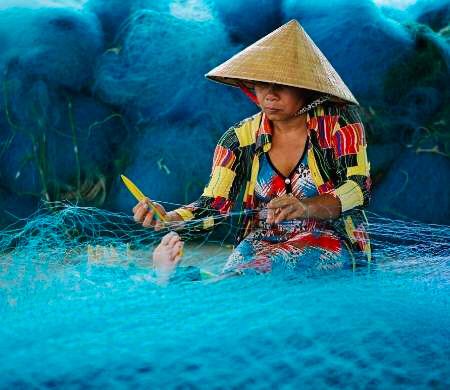Fishing Nets, But Make It Fabric
Fabric made of recycled nylon is making waves in the fashion world, especially when it comes to swimwear.
Whether it’s found in fishing nets or bikinis, there’s no doubt that plastic-based nylon is bad news for the environment. The key is finding an eco-friendly alternative with the same strength, elasticity and water resistance. Cue our introduction to Econyl, a like-new textile yarn made of nylon and plastic waste, such as discarded fishing nets or discarded fabric.
According to Aquafil, the company that manufactures Econyl, producing 10,000 tons of this raw material saves 70,000 barrels of crude oil and more than 57,000 tons of carbon dioxide emissions compared to traditional nylon. This reduces the fabric’s environmental impact by up to 80%. The collection process also helps eliminate part of the 640,000 tons of fishing gear that gets lost at sea every year, which makes up for about 10% of aquatic plastic pollution.
Econyl is certainly more sustainable than virgin nylon on paper, but it does have physical limitations. The fabric is not ideal for creating swimwear on its own, so it is often mixed with another pliable fiber like elastane (also known as spandex or Lycra), which is made of virgin plastic and uses crude oil in its production.
No one really has the silver-bullet solution for circularity, but one of the things that is promising about synthetics is that they can be recycled infinitely. —Kathleen Talbot
Econyl-based swimwear does have an environmental downside: Microfibers in the material shed when washing our bikinis and ultimately end up in the ocean. Some residual shedding is inevitable at this time, however, there are solutions to minimize the number of microplastics being released into the environment.
The best way to reduce the shedding of microplastics is to hand-wash these garments in cold water while utilizing a washing bag, which captures microfibers before they’re drained into waterways.
While intentional and thoughtful in practice, this solution is flawed. Once the microfibers are collected, they will end up in landfills, and potentially waterways, if discarded in the trash. Perhaps we could instead use these microplastic pieces in environmentally minded art projects so that they can be transformed from something destructive into a thought-provoking masterpiece.
Ultimately, we’re still waiting for a completely biodegradable swimsuit fabric that contains no microfibers, or at least a solid recycling system for microplastics. Until then, Econyl is suitable and revolutionary paving the way for truly sustainable swimwear.





